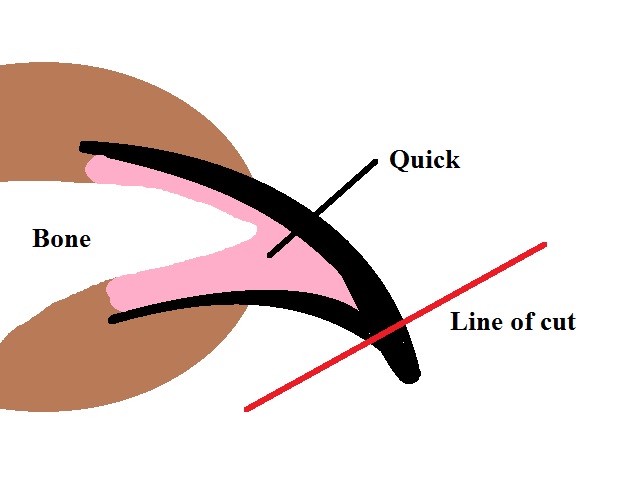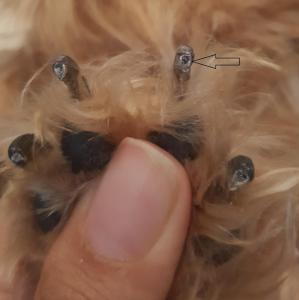==Nail clipping, although sometimes a very stressful endeavor, does carry a lot of benefits for both you and your pet. When nails get too long, there can be a higher risk of your pet catching them on things. This could result in the nail getting pulled on and in some cases the nail can come off! If your pet has particularly curly nails and they grow too long they can grow into your pet’s paw pads, this can become very painful for them. This can also increase the chances of an infection occurring. Long nails can also offset your pet’s gait which in turn can result in joint problems down the line.
Getting your pet used to having nail clips allows them to grow accustomed to having their feet handled and can strengthen the trust they have for you. This can make vet visits less stressful as your pet will tolerate physical examination much better. Knowing how to take care of your pet’s claws can be a very rewarding experience.
How best to clip your pet’s nails
When starting out with clipping your pet’s nails it is best to first get them used to having you touch their paws. Choose a few times throughout the day, when they are relaxed, to run your fingers between their toes and gently squeeze the feet. Keep an eye on their response to gauge their reaction. If your pet is particularly sensitive to having their feet handled start out with doing this for short bursts and work your way up to being able to do this for longer at one time. Work at your pet’s pace and offer lots of praise.
Once you feel you and your pet are ready, try clipping very small amounts off of the tip of each nail. Make sure you use clippers which are a suitable size for cutting your pet’s claws. Do not try to clip the right amount off of each claw in one go as you may accidentally catch the quick (the part of the claw with blood vessels and nerves) which is painful and will cause the claw to bleed. The snapping sound of the nails being clipped may alarm your pet, and this can result in anxiety so again make sure to go at their pace and offer lots of praise and treats. If need be, take a break between each claw and try to work up to being able to do all four paws in one sitting.
For dogs, some nails will be dark and some nails will be light, lighter nails tend to be easier to clip as you are able to see the quick (this is the pink bit), so it is easier to avoid cutting the claws too short. When cutting these claws don’t aim for the very end of the quick, try and leave some leighway as they can sometimes be longer than they look! Darker claws are more of a challenge and it can take practice before knowing just how short to go. When cutting darker claws always try to cut little bits at a time until eventually you reach the quick. As you cannot see the quick in dark claws, the only way to tell you are at the right length is looking for the ‘bullseye’. This looks like a small flesh-coloured circle that you will see in the middle of the claw as you look at the end of the nail. Once you see this do not go any shorter.
Unfortunately nail clipping does take practice and time to build up experience in knowing your pet’s nail, so do not be disheartened if you cut too short and cause your pet to bleed, even the professionals do it at times too! When this happens just apply firm pressure at the end of the nail with cotton wool or paper towel until the bleeding stops, this can take some time so if you have a helper to help keep your pet still it will be a lot easier to maintain that pressure.
For cats the claws are almost always light coloured, and it is much easier to avoid the quick. Start by gently pushing out the claw and clipping at the point where the nail sharpens, or if you want to go shorter, cut at the point just before the quick.
 How often should I clip my pet’s nails?
How often should I clip my pet’s nails?
Each animal is different and some will have faster growing nails than others, the standard recommendation is every 4 to 6 weeks. If you can hear your dog’s claws scraping the floor when they walk, or if you can see that the nail has grown past the bottom of/curling towards your dog’s pads then usually that is a good indicator that it is time for nail clipping.
For cats it depends on each individual circumstance, if they have access to scratching posts then the claws may need doing less frequently. Usually if you can see the claws curling towards the pad or you can feel that they are too sharp then that can be an indicator that they need clipping.
We’re here to help
We know it’s not always easy to clip your pet’s claws, some pets will tolerate nail clipping more than others. If you struggle with your pet you can always book in with one of our registered veterinary nurses for a claw clip. We’re here to support you and your pet. From clipping the claws to showing you the best way to do it at home yourself, we are happy to help!
Additional tips!
- Use the claw clippers to cut up a carrot. This gets your pet used to the sound of the clippers and results in a tasty treat!
- Cut at the best angle, usually this is the angle between your pet’s pad and the end of the nail.
- Some nails can grow close to the pad, make sure when clipping the claws that the clippers do not accidentally catch the skin on the pad.
- Don’t forget the dew claws!
- If your pet is particularly furry, use the opportunity to check that there isn’t excessive fluff between the pads as this can reduce the amount of grip your four-legged has on the floor. In older dogs shaving out this fluff can be very beneficial for their joints.



